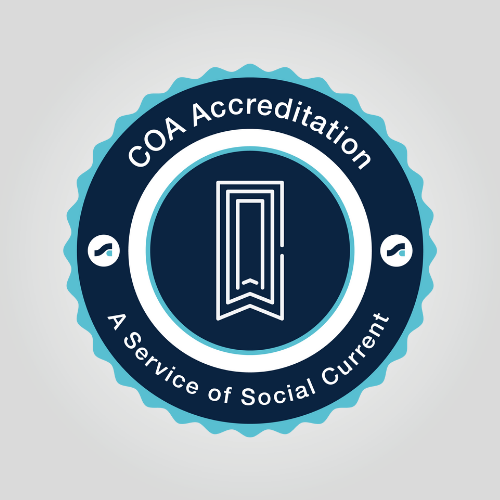June 21, 2022 @ 3:00 pm – 3:30 pm EDT
This free 30-minute webinar provides an introduction to Social Current and COA Accreditation. It is perfect for anyone seeking accreditation for the first time, interested in what is required to become accredited, or mandated to become accredited by state or federal legislation.
Participants will gain an understanding of the key concepts that define COA Accreditation, the steps toward becoming accredited, and the benefits of accreditation. There will also be a Q&A portion for us to answer any questions you might have.
Presenter

Joe Perrow
Network Growth Manager
Social Current
Related Events
June 8, 2022 @ 3:00 pm – 3:30 pm EDT
This free 30-minute webinar provides an introduction to Social Current and COA Accreditation. It is perfect for anyone seeking accreditation for the first time, interested in what is required to become accredited, or mandated to become accredited by state or federal legislation.
Participants will gain an understanding of the key concepts that define COA Accreditation, the steps toward becoming accredited, and the benefits of accreditation. There will also be a Q&A portion for us to answer any questions you might have.
Presenter

Joe Perrow
Network Growth Manager
Social Current
Related Events
May 10, 2022 @ 3:00 pm – 3:30 pm EDT
This free 30-minute webinar provides an introduction to Social Current and COA Accreditation. It is perfect for anyone seeking accreditation for the first time, interested in what is required to become accredited, or mandated to become accredited by state or federal legislation.
Participants will gain an understanding of the key concepts that define COA Accreditation, the steps toward becoming accredited, and the benefits of accreditation. There will also be a Q&A portion for us to answer any questions you might have.
Presenter

Joe Perrow
Network Growth Manager
Social Current
Related Events
The 2022 edition of updates to the standards for COA Accreditation, a service of Social Current, have recently been released. These targeted enhancements to the standards are the result of our annual process and include changes based on ongoing collection and analysis of feedback received from our network, collaboration with diverse groups of subject matter experts, and a review of research and professional literature on identified trends and evolving practices.
Our collaborative update process is designed to ensure the standards remain up-to-date and field-informed, promoting improved outcomes for individuals, families, and communities.
Who’s Affected
These changes impact private, public, and Canadian accredited organizations. The 2022 edition of updates will not impact organizations that are currently pursuing accreditation or re-accreditation and have already been assigned standards in the MyCOA portal.
When It’s Happening
Standards will officially be released on the Social Current website on March 30.
Standards assignments for COA Accreditation begin April 4.
What’s Changing in Our Standards
New Standards for Office-Based Opioid Treatment (DTX)
We have revised our standards for Day Treatment Services (DTX) to accommodate providers offering medication-assisted treatment under the Drug Addiction Treatment Act of 2000. The American Society of Addiction Medicine identifies ongoing maintenance medication with appropriate psychosocial treatment as the gold standard of care for opioid use disorder. Within the context of the opioid epidemic, this work supports improved access to quality programs offering this evidence-based treatment. The 2022 updates to DTX include:
- Two new personnel standards for programs providing office-based opioid treatment
- New personnel standards for peer support providers working in DTX programs
- Expanded training requirements for clinical personnel providing treatment for alcohol and drug use disorders
- A new Core Concept Standard, DTX 9: Office-Based Opioid Treatment
- Interpretations and Examples throughout DTX to support standard implementation within the context of office-based opioid treatment programs
Additional Revisions
In response to feedback from our network, we are also releasing many minor revisions throughout the COA Accreditation standards to provide clarity and/or remain current with trends in the field. Some of the highlights include:
- Clarifying the applicability of various standards through updated NAs (Not Applicable) and Notes
- Updating the glossary with new and updated definitions, including a new definition for therapeutic interventions
- Updated standards on several key practices including maintaining Naloxone on site (ASE 6.03) and the annual Board review of overall risk (GOV 5.05)
A full list of standards impacted by the 2022 updates can be found online.
Our Process
The 2022 COA Accreditation standards updates reflect changes made based on evolving practices, ongoing review of relevant literature, and the continuous feedback we receive from our network, including volunteer reviewers and accredited organizations. More specifically, updating the 2022 Standards involved:
- Collection, in-depth review, and synthesis of prominent published research and professional literature in targeted areas
- Review of standards drafts and discussion of trends in the field with Standards Advisory Panels comprised of subject matter experts, agency leaders, and service providers
- Collection and review of feedback solicited from Social Current’s network, including through the “Provide Feedback” button found in the MyCOA and VIP portals
- Sharing drafts online for a period of field comment to solicit feedback from Social Current’s network and the broader social service sector
Questions?
If you are an in-process or accredited organization, reach out to your accreditation coordinator.
If you are seeking accreditation for the first time, contact Joe Perrow.
For additional information about COA Accreditation standards, contact Melissa Dury.
March 22, 2022 @ 3:00 pm – 3:30 pm EDT
This free 30-minute webinar provides an introduction to Social Current and COA Accreditation. It is perfect for anyone seeking accreditation for the first time, interested in what is required to become accredited, or mandated to become accredited by state or federal legislation.
Participants will gain an understanding of the key concepts that define COA Accreditation, the steps toward becoming accredited, and the benefits of accreditation. There will also be a Q&A portion for us to answer any questions you might have.
Presenter

Joe Perrow
Network Growth Manager
Social Current
Related Events
March 10, 2022 @ 3:00 pm – 3:30 pm EST
This free 30-minute webinar provides an introduction to Social Current and COA Accreditation. It is perfect for anyone seeking accreditation for the first time, interested in what is required to become accredited, or mandated to become accredited by state or federal legislation.
Participants will gain an understanding of the key concepts that define COA Accreditation, the steps toward becoming accredited, and the benefits of accreditation. There will also be a Q&A portion for us to answer any questions you might have.
Presenter

Joe Perrow
Network Growth Manager
Social Current
Related Events
December 12, 2022 @ 1:30 pm – 4:30 pm EST
The Intensive Accreditation Training (IAT) is designed to prepare organizations to get the most out of their COA Accreditation experience. Topics discussed in this training include:
- An in-depth overview of the COA Accreditation process, including key milestones
- An overview of accreditation standards and the relationship between standards, evidence, and the rating indicators
- How ratings are assigned by the volunteer review team and insight on the accreditation decision-making process
- Tips on how to get organized and manage the work
- How to prepare for the site visit
COA Accreditation is offered as a service of Social Current. Learn more about COA Accreditation and how to get started online.
2022 Intensive Accreditation Trainings
This training will be offered five times in 2022. Register now for any session:
Who Should Participate
- Organization primary contacts
- Senior leaders at organizations seeking COA Accreditation
- Other staff involved in an organization’s accreditation process
Related Events
June 27, 2022 @ 1:30 pm – 4:30 pm EDT
The Intensive Accreditation Training (IAT) is designed to prepare organizations to get the most out of their COA Accreditation experience. Topics discussed in this training include:
- An in-depth overview of the COA Accreditation process, including key milestones
- An overview of accreditation standards and the relationship between standards, evidence, and the rating indicators
- How ratings are assigned by the volunteer review team and insight on the accreditation decision-making process
- Tips on how to get organized and manage the work
- How to prepare for the site visit
COA Accreditation is offered as a service of Social Current. Learn more about COA Accreditation and how to get started online.
2022 Intensive Accreditation Trainings
This training will be offered six times in 2022. Register now for any session:
Who Should Participate
- Organization primary contacts
- Senior leaders at organizations seeking COA Accreditation
- Other staff involved in an organization’s accreditation process
Related Events
April 25, 2022 @ 1:30 pm – 4:30 pm EDT
The Intensive Accreditation Training (IAT) is designed to prepare organizations to get the most out of their COA Accreditation experience. Topics discussed in this training include:
- An in-depth overview of the COA Accreditation process, including key milestones
- An overview of accreditation standards and the relationship between standards, evidence, and the rating indicators
- How ratings are assigned by the volunteer review team and insight on the accreditation decision-making process
- Tips on how to get organized and manage the work
- How to prepare for the site visit
COA Accreditation is offered as a service of Social Current. Learn more about COA Accreditation and how to get started online.
2022 Intensive Accreditation Trainings
This training will be offered six times in 2022. Register now for any session:
Who Should Participate
- Organization primary contacts
- Senior leaders at organizations seeking COA Accreditation
- Other staff involved in an organization’s accreditation process
Related Events
February 16, 2022 @ 3:00 pm – 3:30 pm EST
This free 30-minute webinar provides an introduction to Social Current and COA Accreditation. It is perfect for anyone seeking accreditation for the first time, interested in what is required to become accredited, or mandated to become accredited by state or federal legislation.
Participants will gain an understanding of the key concepts that define COA Accreditation, the steps toward becoming accredited, and the benefits of accreditation. There will also be a Q&A portion for us to answer any questions you might have.
Presenter

Joe Perrow
Network Growth Manager
Social Current


